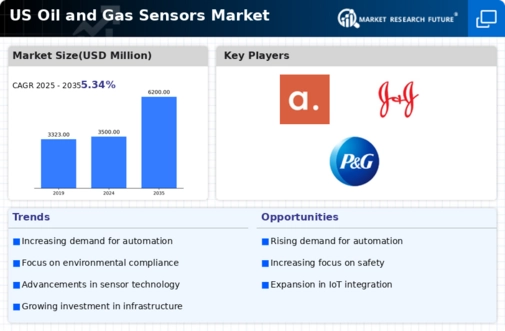Focus on Operational Efficiency
The oil gas-sensors market is significantly influenced by the industry's focus on operational efficiency. Companies are increasingly adopting sensor technologies to streamline processes, reduce costs, and enhance productivity. In 2025, it is projected that operational efficiency initiatives could lead to cost savings of approximately $50 billion across the sector. This emphasis on efficiency drives the demand for sensors that can monitor equipment performance, detect leaks, and optimize resource usage. As organizations strive to improve their bottom line, the oil gas-sensors market is likely to experience robust growth, as these technologies become integral to achieving operational excellence.
Integration of IoT Technologies
The integration of Internet of Things (IoT) technologies into the oil gas-sensors market is transforming operational efficiencies and data management. IoT-enabled sensors facilitate real-time monitoring and data collection, allowing companies to optimize their operations and reduce downtime. In 2025, it is estimated that the adoption of IoT in the oil and gas sector could enhance productivity by up to 15%. This technological shift is likely to drive the demand for sophisticated sensors that can seamlessly connect to IoT platforms. As companies seek to leverage data analytics for predictive maintenance and operational insights, the oil gas-sensors market stands to benefit significantly from this trend, fostering innovation and enhancing overall performance.
Emerging Environmental Regulations
this market is being shaped by emerging environmental regulations aimed at reducing emissions and promoting sustainable practices.. Regulatory bodies are increasingly mandating the use of advanced sensor technologies to monitor environmental impacts and ensure compliance with stringent standards. In 2025, it is anticipated that compliance-related expenditures in the oil and gas sector will reach $30 billion, driving the demand for sensors that can accurately measure emissions and other environmental parameters. This regulatory landscape compels companies to invest in innovative sensor solutions, thereby propelling growth in the oil gas-sensors market as organizations seek to align with environmental mandates.
Rising Demand for Safety Solutions
The oil gas-sensors market is experiencing a notable increase in demand for safety solutions, driven by the need to mitigate risks associated with hazardous environments. As the oil and gas industry continues to expand, the implementation of advanced sensor technologies becomes crucial for ensuring worker safety and environmental protection. In 2025, the market for safety sensors is projected to reach approximately $1.5 billion, reflecting a growth rate of around 8% annually. This trend indicates that companies are prioritizing investments in safety measures, which in turn propels the oil gas-sensors market. Enhanced safety protocols not only protect personnel but also minimize the potential for costly accidents, thereby reinforcing the importance of sensor technologies in the industry.
Increased Investment in Exploration Activities
The oil gas-sensors market is poised for growth due to increased investment in exploration activities. As energy demands rise, companies are allocating substantial resources to discover new oil and gas reserves. In 2025, exploration budgets are expected to exceed $200 billion, leading to a heightened need for advanced sensor technologies that can provide accurate data on subsurface conditions. These sensors play a critical role in exploration by offering insights into geological formations and potential drilling sites. Consequently, the oil gas-sensors market is likely to see a surge in demand as companies seek to enhance their exploration capabilities and ensure efficient resource extraction.













Leave a Comment